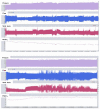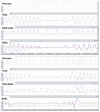Monitoring Systems in Home Ventilation
- PMID: 36983171
- PMCID: PMC10054628
- DOI: 10.3390/jcm12062163
Monitoring Systems in Home Ventilation
Abstract
Non-invasive ventilation (NIV) is commonly used at home for patient with nocturnal hypoventilation caused by a chronic respiratory failure. Monitoring NIV is required to optimize the ventilator settings when the lung condition changes over time, and to detect common problems such as unintentional leaks, upper airway obstructions, and patient-ventilator asynchronies. This review describes the accuracy and limitations of the data recorded by the ventilator. To efficiently interpret this huge amount of data, clinician assess the daily use and regularity of NIV utilization, the unintentional leaks and their repartition along the NIV session, the apnea-hypopnea index and the flow waveform, and the patient-ventilator synchrony. Nocturnal recordings of gas exchanges are also required to detect nocturnal alveolar hypoventilation. This review describes the indication, validity criteria, and interpretation of nocturnal oximetry and transcutaneous capnography. Polygraphy and polysomnography are indicated in specific cases to characterize upper airway obstruction. Telemonitoring of the ventilator is a useful tool that should be integrated in the monitoring strategy. The technical solution, information, and limitations are discussed. In conclusion, a basic monitoring package is recommended for all patients complemented by advanced monitoring for specific cases.
Keywords: chronic respiratory failure; monitoring; noninvasive ventilation; telemonitoring.
Conflict of interest statement
J.-M.A. is consultant for Resmed and Breas Medical. M.O. received honorarium from Lowenstein Medical for education activities. J.G.-B. is consultant for Breas Medical and Lowenstein Medical.
Figures











References
Publication types
LinkOut - more resources
Full Text Sources

